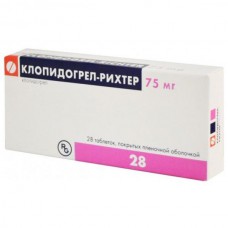Expiration date: 04/2026
Form of issue.
Tablets, film-coated
Composition.
1 tablet contains clopidogrel hydrosulfate 97.875 mg, equivalent to clopidogrel — 75 mg
Auxiliary substances: starch pregelatinization. anhydrous lactose (milk sugar, anhydrous), macrogol (polyethylene glycol 6000). magnesium stearate. cellulose microcrystalline (PH 112), castor oil hydrogenated, the composition of the membrane shell:Selichot AQ–01673 (hypromellose (hydroxypropylmethylcellulose), macrogol (polyethylene glycol 400), macrogol (polyethylene glycol 6000), titanium dioxide, aluminum lacquer dye Ponceau 4 R).
Pharmacological action.
Clopidogrel is a specific and active inhibitor of platelet aggregation, has koronrodilatirtee action. Selectively reduces the binding of ADP receptors on platelets and activation of the receptors of the GPI Ib/IIIa by the action of ATP. attenuating platelet aggregation. Reduces agregatia platelets, caused by other agonists, preventing activation of the released ADP, does not affect the activity of phosphodiesterase (PDE). Irreversibly binds to ADP-receptors platelets, which remain impervious to the stimulation of ADP throughout the life cycle (about 7 days). Inhibition of platelet aggregation is observed 2 hours after administration (40% inhibition) initial dose of 400 mg. the Maximum effect (60% suppression of aggregation) develops after 4-7 days of admission dose 50-100 mg/day. Antiplatelet effect lasts for the entire period of life of platelets (7-10 days). In the presence of atherosclerotic lesions of the vessel prevents the development of atherothrombosis regardless of the localization of vascular process (cerebrovascular. cardiovascular or peripheral lesions).
Testimony.
Prevention of thrombotic complications:
- after myocardial infarction (from a few days up to 35 days), ischaemic stroke (from 6 days to 6 months) or when diagnosed disease of peripheral arteries,
- in acute coronary syndrome without ST-segment elevation (unstable angina or myocardial infarction without pathological Q wave), including patients undergoing surgery for percutaneous coronary artery bypass grafting, in combination with acetylsalicylic acid,
- in acute coronary syndrome with ST-segment elevation (acute myocardial infarction) in combination with acetylsalicylic acid, in patients receiving drug treatment with possible use of thrombolytic therapy.
Contraindications.
- Hepatic insufficiency of severe degree,
- acute bleeding (for example, peptic ulcer or intracranial hemorrhage),
- pregnancy
- breastfeeding,
- the age of 18 years (safety and efficacy not established),
- hypersensitivity to the drug.With caution should designate product in the liver and kidney (i.e. with moderate hepatic and/or renal failure), trauma, preoperative conditions.
Method of application and doses.
Clopidogrel is taken orally, regardless of meals.
For prevention of coronary abnormalities in patients after myocardial infarction, ischemic stroke and diagnosed peripheral artery disease is 75 mg 1 time/day. Treatment should begin within a few days to 35 days after myocardial infarction and from 7 days to 6 months after ischemic stroke.
In acute coronary syndrome without ST-segment elevation (unstable angina or myocardial infarction without tooth Q) treatment should begin with the appointment of a single loading dose 300 mg, then continue to use the drug in a dose 75 mg 1 times/day (with simultaneous appointment of acetylsalicylic acid at a dose 75-325 mg/day). Since the use of acetylsalicylic acid in high doses is associated with a greater risk of bleeding, the recommended dose should not exceed 100mg. the Course of treatment - up to 1 year.
In acute myocardial infarction with ST-segment elevation the drug appoint one dose 75 mg 1 times/day using an initial loading dose in combination with acetylsalicylic acid, in combination or without thrombolytics. For patients older than 75 years, treatment with clopidogrel should be undertaken without the use of a loading dose. Combination therapy is started as early as possible after the onset of symptoms and continued for at least 4 weeks.
Special instructions.
During treatment necessary to monitor the indicators of hemostasis system (activated partial thromboplastin time (APTT), number of platelets, tests of functional activity of platelets), regularly examine the functional activity of the liver.
Clopidogrel should be used with caution in patients with risk of severe bleeding in trauma, surgical intervention, patients receiving acetylsalicylic acid, non-steroidal anti-inflammatory drugs (including COX-2 inhibitors), heparin or inhibitors of glycoprotein IIb/IIIA. Careful monitoring of patients to detect any signs of bleeding, including hidden, especially during the first weeks of the drug and/or after invasive procedures on the heart or surgery. When planning surgical intervention, treatment with clopidogrel should be discontinued 7 days before surgery.
Patients should be warned that stopping the bleeding will take more time than usual, so they should inform the doctor about each case of bleeding.
Were marked by rare cases of thrombotic thrombocytopenic purpura (TTP) after receiving clopidogrel. This condition is characterized by thrombocytopenia and microangiopathic hemolytic anemia in combination with neurological symptoms, renal dysfunction or fever. The development of TTP is life threatening and requires urgent measures, including the holding of plasmapheresis. Due to insufficient amount of data, clopidogrel should not be administered in the acute period of ischemic stroke (first 7 days). The drug should be administered with caution in patients with impaired renal function.
Clopidogrel should be administered with caution to patients with moderate liver dysfunction, which may cause hemorrhagic diathesis.
In patients with congenital galactose intolerance, malabsorption syndrome of glucose-galactose and lactase deficiency should not take clopidogrel.
Drug interactions.
The combined use of clopidogrel with warfarin is not recommended as this combination may intensify the bleeding.
The appointment of inhibitors of glycoprotein IIb/IIIA in conjunction with clopidogrel increases the risk of bleeding.
The use of nonsteroidal anti-inflammatory drugs in conjunction with clopidogrel increases the risk of bleeding.
Not recommended concomitant use of clopidogrel with CYP2C19 inhibitors (e.g. omeprazole).
Not clinically significant pharmacodynamic interaction with clopidogrel use in conjunction with atenolol, nifedipine,phenobarbital, cimetidine, estrogens, digoxin, theophylline, tolbutamide, antacids.
Overdose.
Symptoms: prolonged bleeding time and subsequent complications.
Treatment: the occurrence of bleeding should be carried out appropriate therapy. If you need a fast correction of the lengthening of bleeding time, it is recommended that the platelet transfusion. There is no specific antidote.


